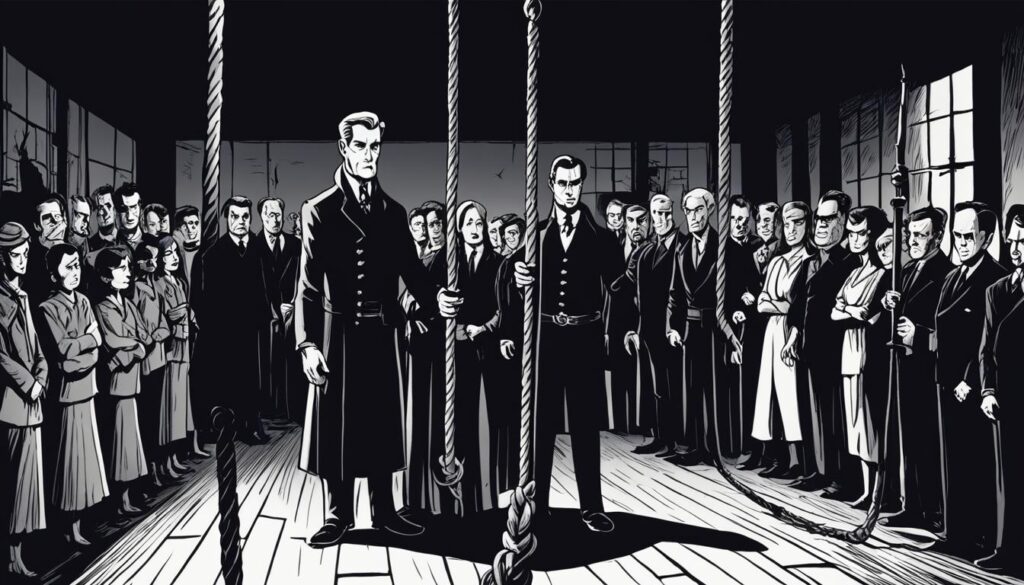In the fifth and final installment of James Clemens’ The Banned and the Banished series, Wit’ch Star, the epic saga reaches its conclusion. This book has garnered attention for its improved writing quality and character development compared to earlier books in the series.
Set in a richly imagined fantasy world, Wit’ch Star delves deeper into the intricacies of the story, captivating readers with its engrossing plot and compelling narrative. James Clemens’ writing has evolved, drawing readers into a more immersive experience that brings his characters to life.
Although the overall reception of the book is positive, there are some cons that have been highlighted by readers. These include issues with certain characters, a lack of interest in the story, and contrived plot elements that may affect the overall reading experience.
Key Takeaways:
- Improved writing quality and enhanced character development make Wit’ch Star stand out among earlier books in the series.
- Certain characters in the book, such as Harlequin Quail, may not contribute significantly to the story, affecting overall character execution.
- Literal interpretations and the concept of “The One” have garnered mixed reactions from readers.
- Villains in Wit’ch Star, particularly Ly’chuk, are viewed as lacking depth and impact.
- The forewords in the book do not fulfill their intended purpose, detracting from their potential impact.
Improved Writing Quality and Character Development
Readers have praised the noticeable improvement in writing quality in “Wit’ch Star” compared to earlier books in the series. The author, James Clemens, has honed his craft and delivered a more refined and engaging narrative. The prose is tighter, the descriptions are vivid, and the pacing is well-balanced, keeping readers hooked from start to finish.
Furthermore, the character development in “Wit’ch Star” is a standout aspect of the book. Readers have applauded Clemens for giving his characters more depth, complexity, and growth. Each character’s journey is well-explored, providing a satisfying sense of personal evolution that adds layers to their interactions and motivations. As readers delve into the story, they witness the characters’ transformation, making them more relatable and enhancing the overall reading experience.
To put it simply, the improved writing quality and skillful character development in “Wit’ch Star” contribute to its appeal as a satisfying conclusion to The Banned and the Banished series. The combination of compelling prose and well-rounded characters creates a captivating world that readers can immerse themselves in.
Cons in Character Execution
While Wit’ch Star receives praise for its improved writing quality and character development, there are certain cons highlighted by readers regarding the execution of certain characters. One specific character, Harlequin Quail, is introduced late in the series and does not add much to the overall story. Some readers have found this character’s presence to be unnecessary and lacking in significance.
In addition, there are criticisms about other characters in the book, particularly in relation to their repetitive and unrealistic reactions to situations. These characters often display predictable behavior, which can diminish the sense of realism and authenticity within the narrative.
These issues with character execution can detract from the overall reading experience, as readers may find it more challenging to connect with and invest in the characters. A well-executed and engaging cast is essential for a compelling story, and when character development falls short, it can impact the overall enjoyment and believability of the book.

The One and Literal Interpretations
The concept of “The One” and literal interpretations in James Clemens’ Wit’ch Star has generated mixed reactions among readers. Throughout the book, the idea of two characters becoming one is used as a symbolic representation of their importance. However, some readers find this concept mildly silly, while others appreciate its metaphorical significance within the story.
An interesting aspect regarding literal interpretations is also present in Wit’ch Star. There are instances where different types of fire are used in the narrative, representing various symbolic meanings. However, some readers have raised concerns that these literal interpretations may appear unrealistic or overly simplistic.
Overall, the inclusion of “The One” and literal interpretations in Wit’ch Star adds depth and layers to the storytelling. While opinions may vary, it is important to acknowledge the author’s creative choices in conveying important themes and concepts throughout the book.
Readers’ Reactions
- Some readers find the concept of two characters becoming one to be mildly silly.
- Others appreciate the metaphorical representation of the characters’ importance.
- Literal interpretations, such as the use of different types of fire, have been seen as both symbolic and unrealistic by different readers.
- There is a range of opinions regarding the effectiveness of “The One” and literal interpretations in enhancing the overall reading experience.
Flaws in Villain Characters
Although Wit’ch Star showcases improved writing quality and character development, there are some notable flaws in the portrayal of the villain characters. In particular, the main antagonist, Ly’chuk, fails to live up to expectations, lacking the depth and impact that readers anticipated. Despite the potential for a stronger and more captivating portrayal, Ly’chuk ultimately falls short, leaving readers disappointed.
On the other hand, there are instances of well-executed character development among the villains. Greshym, a supporting antagonist, undergoes significant growth throughout the story, engaging readers with his interesting scenes and intriguing transformation. However, the character’s ultimate demise is met with an anticlimactic death, which dampens the overall impact of his development.
These flaws in the villain characters hinder the story’s ability to create a captivating narrative and fully immerse readers in the world of Wit’ch Star. Adequate development and compelling portrayals of antagonists are crucial for building tension, creating conflict, and enhancing the overall reading experience.
| Villain Character | Flaws |
|---|---|
| Ly’chuk | Lacks depth and impact |
| Greshym | Anticlimactic death despite compelling development |
Unexplored Potential in Forewords
The forewords in Wit’ch Star play a significant role in providing insight into the timeframe and setting the stage for the story. However, readers have noted that these forewords lack purpose and often forget about them once they start delving into the main narrative. The disconnect between the forewords and the rest of the book leaves unexplored potential, diminishing their intended impact and potentially leaving readers confused or disengaged.
To fully grasp the impact of this unexplored potential, consider the following comparison:
| Strengths of Forewords | Unexplored Potential |
|---|---|
|
|
Without proper integration into the storytelling, the forewords miss the opportunity to enhance the reader’s understanding and immersion in the world of Wit’ch Star. As a result, readers may not fully appreciate the depth and intricacy of the story’s context, potentially impacting their overall enjoyment and connection to the book.
Critique of the Triad Battle
The battle with the corrupted Triad at the Spirit Gate is regarded by some readers as contrived and unnecessary. There is a lack of clear justification for the occurrence of this battle, and it does not significantly contribute to the overall progression of the story. This critique highlights the importance of meaningful and purposeful plot elements.
| Critique Points | Impact on Story |
|---|---|
| Contrived and unnecessary | No significant contribution to the overall progression of the story |
| Lack of clear justification | Does not add depth or further the storyline |
Lack of Initial Interest
One of the major cons noted by readers is the lack of initial interest in the series as a whole. The writing quality, character development, and world-building in earlier books are seen as subpar, which challenges the reader’s engagement with the story. Establishing reader interest from the beginning is crucial for the success of a series.
Conclusion
Wit’ch Star, the final installment in the critically acclaimed The Banned and the Banished series by James Clemens, showcases both strengths and weaknesses. Readers have commended the book for its improved writing quality and deeper character development, which enhance the overall reading experience. However, there are several notable criticisms that cannot be overlooked.
One significant drawback lies in the execution of certain characters, such as the belated introduction of Harlequin Quail, who fails to contribute substantially to the narrative. Additionally, some characters are criticized for their repetitive and unrealistic reactions to situations, which diminishes their authenticity and impact.
Furthermore, the series initially struggles to capture the readers’ interest due to subpar writing, character development, and world-building in earlier books. This lack of engagement can heavily influence the overall perception of the story and hinder its success.
Despite these criticisms, Wit’ch Star does offer a satisfying conclusion, as it concludes numerous storylines and ties up loose ends. While the book may not be flawless, it serves as a testament to James Clemens’ growth as a writer and his commitment to delivering a captivating story. Ultimately, the final thoughts on Wit’ch Star are a mixture of commendation for its improvements and reservations about certain aspects, making the book a worthwhile read for fans of the series.



